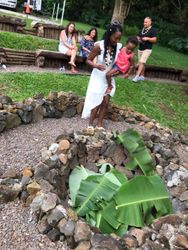
The luau leaf is an important aspect of traditional Hawaiian luaus. Part of the taro plant, these large green leaves are used in a variety of dishes, but their cultural significance is just as important as their place in Hawaiian cuisine. Learning about the leaf’s history is one way to develop a greater understanding of Hawaii’s culture.
The History of the Luau Leaf
The Origin of Kalo
Luau leaves come from the taro plant. In Hawaii, taro is called “kalo,” which refers to the physical manifestation of the demigod Hāloa. The legend of Hāloa dates to the beginning of the Hawaiian people. His father is Wākea, the expanse of the heavens, and his mother is Hoʻohōkūkalani, which means “to adorn the heavens with stars.” Her mother, Hāloa’s grandmother, is Papa, the foundation that is earth.
The child Hāloa was stillborn. His parents buried him on the eastern side of their home, the side the sun rose upon. A plant with a long stalk and large, heart-shaped leaves began to grow in this spot. This was the first kalo plant, also known as Hāloanakalaukapalili.
When Hoʻohōkūkalani became pregnant again, her healthy baby boy was named Hāloa as well, in honor of his deceased older brother. This baby grew up to be the first Hawaiian. All Hawaiians can trace their lineage back to him. This origin story connects Hawaiians to nature, as it implies that everything on the island is their ancestor.
Luau Leaves Today
 The luau leaf is a staple in Hawaiian cuisine. Just like a compassionate older brother, it takes care of its people and nourishes them. Dishes such as poi are made from taro root, but laulau incorporates the leaves themselves. To make laulau, pork is typically wrapped in layers of luau leaves and cooked in an underground oven. Modern Hawaiian cuisine also uses chicken or fish in place of pork.
The luau leaf is a staple in Hawaiian cuisine. Just like a compassionate older brother, it takes care of its people and nourishes them. Dishes such as poi are made from taro root, but laulau incorporates the leaves themselves. To make laulau, pork is typically wrapped in layers of luau leaves and cooked in an underground oven. Modern Hawaiian cuisine also uses chicken or fish in place of pork.
Other common Hawaiian recipes use luau leaves similarly to other leafy green vegetables like spinach. The leaves can be boiled and sweetened with coconut milk. Some dishes also add a protein to the mix. Cooked luau leaves can also be spread with spiced chickpea paste, rolled, and either steamed or deep-fried. They can also be served as a tasty side dish for curries and pork meals.
For an intimate experience in Hawaiian traditions, visit Experience Nutridge in Honolulu, HI. Their luau events and Hawaiian cultural experiences engage all five senses, incorporating storytelling, arts and crafts, drinks, and cuisine. Guests can even prepare a delicious dinner made from the best local ingredients. You can also book an authentic private luau for a group of 30 or more guests while taking in the exquisite sunset views of the island. To learn more about their options and to book, call (808) 531-5050. Stop by their website for a look at their Hawaiian cuisine.
About the Business
Have a question? Ask the experts!
Send your question

